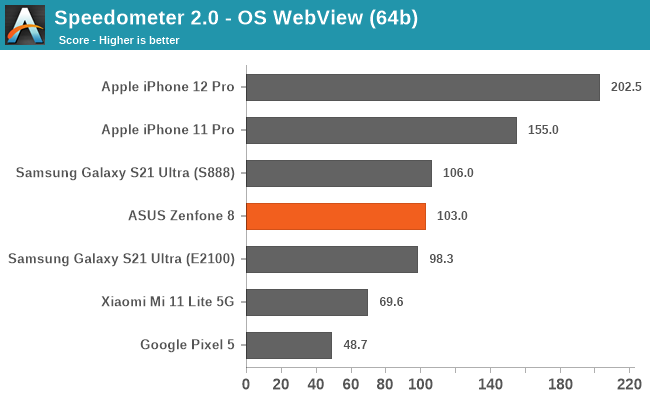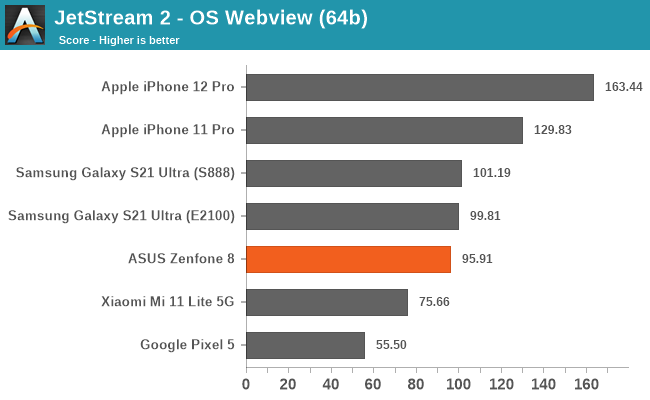The ASUS Zenfone 8 Hands-On Review: A New Compact Direction
by Andrei Frumusanu on May 12, 2021 1:30 PM EST- Posted in
- Smartphones
- Asus
- Mobile
- Zenfone 8
System Performance
System performance of the Zenfone 8 should be quite good virtue of the new Snapdragon 888. On top of that, ASUS’ 120Hz mode and 240Hz touch input rate should result in extremely fluid and responsive experiences.
One thing I have to make note of here is ASUS’s refresh rate modes. By default, the phone comes in the “Auto” mode, which in my experience simply switches between 90 and 60Hz depending on the application. I’ve never actually seen 120Hz used by the phone anywhere in this mode, which is odd. Besides the Auto mode, you can also explicitly set the phone to 120Hz, 90Hz or 60Hz modes all the time. In PCMark and also many other generic applications, Auto mode will switch to 60Hz mode while browser activity will switch to 90Hz mode. I tested that, as well as the explicit 120Hz mode of the phone.





In PCMark which is a good representation of overall device responsiveness, we see that the Zenfone 8 tracks rather very closely to the performance of the Snapdragon 865 powered Zenfone 7, depending on the refresh rate. What’s actually a bit weird is that at 60Hz, the ZF8 is actually a bit slower than the ZF7, a point which I’ll come back to in a bit.


In the browser benchmark, which we’ve lately started from a clean slate due to the new 64-bit browser deployments on Android in the last few months which improve performance compared to past results, we see that the Zenfone 8 tracks closely to the Snapdragon 888 powered Galaxy S21 Ultra, which is expected.
Overall Device Experience - 120Hz Good, Everything Else Bad
At the 120Hz setting, the Zenfone 8 performs extremely well as is as responsive as any other device in the market. What’s actually very strange and extremely concerning for the ZF8 is all the other operating modes, such as 90Hz and 60Hz. For some reason, beyond just a slower refresh rate, these modes have seemingly increased input lag as well as just overall sluggish feel for the device. The 60Hz mode in particular is quite horrible – it feels as if ASUS is also modulating the input touch response based on the refresh rate. Generally speaking, for the best experience, you want to keep the phone in 120Hz always mode and avoid the Auto as well as the lower refresh rate modes.










66 Comments
View All Comments
itsjustaprankbro - Wednesday, May 19, 2021 - link
Yeah, wife also uses S10e. Thought about this phone but she loves wireless charging. There is also the Xiaomi Mi 11 Lite 5G, but also no wireless charging (and no OIS on that one). Sony's compact phones also lack wireless charging, despite costing twice as much. There is only the S20-S21, but those phones have some utterly horrible battery life and performance (minus the Snapdragon models). So I guess, the S10e will have to serve a few more years.BedfordTim - Thursday, May 13, 2021 - link
It was one of the many annoyances of my Nokia 9. I can't imagine going back to 128GB.yetanotherhuman - Saturday, May 15, 2021 - link
I use a phone with 64GB and don't give a shit. I guess we're all different.itsjustaprankbro - Wednesday, May 19, 2021 - link
Silliest comment of the year. If not the decade. Yes, Samsung made 512GB edition of the Note 9. Released 1TB edition of the S10+. And? It keeps releasing the S20 Ultra, S20, S20+, S21 Ultra, S21 and other phones with a measly 128gb storage ONLY. And there is NO dedicated microSD slot (like on the Zenfone 6-7-8), just a hybrid SIM slot.If anything, Samsung is pathetic. Yes, I am salty about their decisions because a new S21 costs an insane amount of cash and it has no storage?
quiksilvr - Wednesday, May 12, 2021 - link
Uh, that plastic gasket piece between the metal frame and display is essential for durability. It is actually something you are supposed to have. Removing it is the cheap move, not the more expensive move.Wereweeb - Wednesday, May 12, 2021 - link
Tell that to people who think a smartphone's function is to look pretty in your hand.eastcoast_pete - Wednesday, May 12, 2021 - link
The problem with your statement is that it's true and thus makes sense 🙂; unfortunately, many people prefer looks over function.arashi - Thursday, May 13, 2021 - link
All iPhones are cheap phones to Andrei maybe. ;)eastcoast_pete - Wednesday, May 12, 2021 - link
Thanks Andrei! I don't like that they dropped the microSD slot; there are fewer and fewer phones in the upper middle and flagship range that have those. Regarding the battery life, maybe ASUS could come out with a Zenphone 8 Lite with everything like this (plus mSD slot, please) , but with the SD 780; plenty fast, much easier on power drawKangal - Thursday, May 13, 2021 - link
I agree 100%.They can't compete when it comes to Software Updates, or Camera Quality, or Customer Service. So there's no point for them to compete in the Luxury/Flagship category.
They should've just made ONE variant: QSD 780, 8GB RAM, 256GB storage, and decreased the price by $100 to compete in the High-end category instead. Don't make different RAM/Storage options, or different 3G/4G/5G radio variants... that's a waste of money.
Their winning strategy against those cheaper Chinese competitors? Just do a clean Stock AndroidOS, have unlockable bootloader, and include the basic features. Basic features are: 3.5mm Jack, microSD, IrDa. Also great features are Front-firing stereo loudspeakers, Flat Display, IP68 protection or User Removable Battery. I know I'd buy it, even with the QSD 780G, as that is actually a Flagship-level Processor, unlike QSD 845 or QSD 768G (or lower).